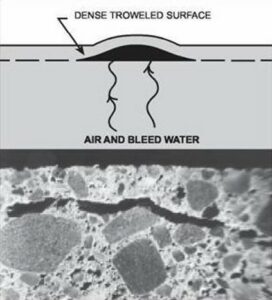When producing concrete, a producer never wants to hear the customer complaining that the concrete has excessive ‘bleed’. Bleed in concrete is the result of excess water being forced to the surface of the concrete. Understanding the cause of bleed can assist in properly managing and eliminating its occurrence.
The four primary ingredients of concrete are stone, sand, cement and water. Of these four ingredients, water is the least dense and is the only liquid. If one were to drop an object into a pile of stone, sand or cement, the object would displace some of the materials to the side, but the object will remain on the surface. However, dropping the object into water causes the object to fall into the water and settle on the bottom causing the water to rise.
The same concept applies in bleed, with the aggregate and cement being the objects that settle to the bottom. Any excess water not absorbed by the sand and cement rise to the surface. This leaves a pool of water on the surface of the concrete, which we call bleed water.
There are four primary ways to reduce the possible occurrence of concrete bleed:
1. Maintain a strict water to cement ratio.
It is said that only a water cement ratio of 0.20 is needed to totally hydrate or cure concrete. However, this would make the concrete very unworkable so typically we use ratios of 0.40-0.50. Any more water added at any time will end up being free water that will be trapped in the concrete or rise to the top causing bleed. Therefore, reducing the water content or adding more cement to the mix design to absorb some of the water, will reduce or eliminate the possibility of bleed.
2. Add sand.
Being a fine particle, sand can absorb water. To reduce bleed with sand, ensure that the sand you are using contains a range of finer particles. The finer the particles, the more absorption occurs. Increasing the sand content and decreasing the coarse aggregate will also help, but be aware of the affects this will have on the design regarding to strength.
3. Add Supplementary Cementous Materials (SCM’s) into your mix.
SCM’s like Fly Ash or Slag are very fine, and usually even finer than cement. If you add these into your mix design, this will increase the water absorption in the mix. The benefits of SCMs also include increased workability, greater strength over time, and lower cost to supplement cement.
4. Add air entrainment to the mix.
Like the other methods, this involves adding more particles to the mix to absorb water. In this case, the particles are air bubbles. Adding tiny air bubbles increases the amount of surface area the cement and water need to cover in the mix, and therefore reduces the total amount of free water than can rise to the surface of the freshly poured concrete.
If bleed does occur, ensure that the finishers do NOT proceed to the finishing stages. Bleed can have almost no effect on the end result of concrete if you just wait a little while before troweling and finishing the concrete. The best approach is to wait and let the water evaporate. If the finisher begins to finish the concrete with the bleed water present, the water will be forced into the top layer and will drastically weaken the concrete.

What can also happen is that the water will be pushed under a thin top layer of cement that hardens. This creates a blister and when that pocket of water evaporates it will become an air cavity. The thin layer then will just flake off in a matter of time. By just waiting 30 minutes, depending on weather conditions, your bleed will be gone by itself and be ready for proper finishing.
If you own a volumetric concrete mixer, just take the water content a touch down for your pours. This will result in stronger concrete. If you are using a ready-mix truck, just wait for the bleed to settle down or do not ask the operator to add any more water.
Although bleeding is a common concern, it can be easily managed. Using the minimum amount of water, but still having enough workability, is the key to strong concrete.